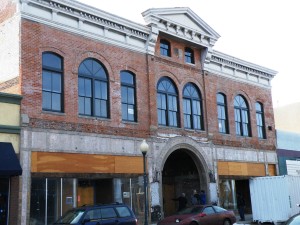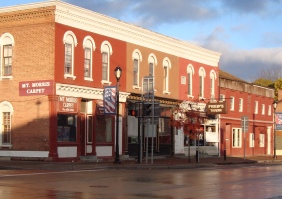(And Simultaneously Building Community Engagement!)
We all recognize that vacant lots not only detract from a community’s vitality, but can also lead to increased crime. And, we know that activating the space for a temporary community use engages community members, leading to a more active and safer area, as the safest areas are those with lots of people. But, the question remains just what should you do with that empty lot?
Below are 27 ideas for transforming your vacant space into a beloved community place, as well as some inspiration and resources to get you started. (DCI members can log into DCI’s Online Resource Library to access additional information.) Some of these ideas are temporary; some could be permanent. Some will require more funding than others—but don’t let lack of funds stop you. In fact, you should embrace this as an opportunity to engage more community members! Reflect on your community’s assets—you might not have the funding to hire a crew to build a temporary outdoor stage, for example, but perhaps your community has a skilled carpenter and a crew of volunteers excited to donate their time.
Keep in mind that the process of activating the community space is just as important as the final outcome and can, in fact, determine the project’s success. The more people a project engages at the planning level, the more community buy-in you will garner and the more people who will show up for your event or project launch.
Not all of the below ideas have resource links because I couldn’t always find a similar example, but that doesn’t mean your community can’t tackle the challenge. Or, just use this list of ideas to jumpstart your own community brainstorm and share with us your ideas!
What community use can you find for an empty lot?
- Organize a community outdoor movie night. Consider screening classic flicks or, even better, showcase any local filmmakers. Try conducting a poll or online vote on which movies your community members would like to see in advance.
Resources:
Fun Flicks
Open Air Cinema: Community Engagement in Small Towns via Outdoor Movies - Paint a community mural to begin reclaiming the space. Engage your community members in the initial brainstorm and implementation.
Resource: Community Public Art Guide: Murals - Host an instrument petting zoo. Do you have a local music store? Invite them to set up instruments that children and those young-at-heart can touch and experiment with. They might be excited enough to sign up for music lessons or purchase that guitar they’ve always been thinking about.
- Install miniature scenes. An artist in the UK creates miniature “scenes” on city streets and then leaves them to be discovered. You could engage local artists, community members, or kids to create tiny scenes throughout a space and then invite the community to come discover them. Children love anything that is so much smaller than they are. (Think of the popularity of the outdoor fairy homes and gardens—or is that just my family?)
Inspiration: Miniature City Scenes: 21 of Slinkachu’s Tiny Art Installations - Host an outdoor theater-in-the-round. You don’t necessarily need a traditional stage to host an outdoor theater. Set up folding chairs on all sides of a cleared area and you have an instant theater-in-the-round. Conduct outreach to local theater groups, including local universities or colleges or high schools.
- Host an outdoor concert. Consider local professionals or area youth. A children’s musical event gets you a guaranteed audience of parents and grandparents!
Resource: Running an Open Air Concert - Host an outdoor dance with a live band. Rent an outdoor dance floor and string up some twinkle lights to host an old-fashioned dance under the stars. Again, look to your local musicians who are likely to already have a local following.
- Install a temporary parklet. A parklet is usually described as a small public space extending from the sidewalk, or it can be take over a former parking space. Consider converting a little-used parking area into a temporary parklet by creating inviting areas for community members to linger.
Resource: Grand Rapids Parklet Manual
Inspiration:
Oakdale council proposing parklet for empty lot (Pennsylvania)
LA’s pocket parks bring people together (Los Angeles) - Set up an artisans market. Send out a call for local artisans and artists to participate.
- Host a children’s pop-up event. This could be a lemonade stand, baked goods, or whatever else children will sell.
- Set up a wine tasting. Is there a local wine store you could partner with that might be able to donate wine?
- Host an outdoor dinner. This could be more formal by engaging a local restaurant or chef, or you could create an informal potluck.
Inspiration: The Dining Room Takes to The Streets (New York) - Create a pop-up plaza. This provides the opportunity to consider public uses for the space while temporarily using the space. Utilize moveable street furniture to create places for people to linger, and food to give them something to linger over. Consider having someone on-site to survey participants on how they would like to utilize the space in the future.
Inspiration:
Pop-up Plaza Brings Tactical Urbanism to Somerville by Design (Somerville, MA)
Pop-Up Plaza Enhances Art Walk, Hints at What Could Be in Leimert (Los Angeles, CA) - Install a complimentary coffee or tea cart. Let’s face it…we all love free. Check out Portland’s Share-It Square for ideas on how to keep an unmanned tea cart operating. (Look for the 24-7 tea cart.)
Inspiration: Paint the Intersection at Share-It Square (Portland) - Invite food trucks to gather for a special day. Your community might not be able to support food trucks on a daily basis, but perhaps you could invite some for a special event. For local restaurant owners who may balk at this, many communities have found that this actually generates more revenue overall for everyone. But, you could certainly consider inviting food trucks that serve different food than your local restaurant fare.
- Create a bike parking lot. Community members are much more likely to get out of their cars and bike if you offer secure bike parking. Why should you care if your community bikes? In addition to this being a healthy mode of transportation for individuals and the environment, people who bike are more likely to stop their bike and walk around your downtown. And, more feet on the street means a more vital district.
Resource: Bicycle Parking Guidelines, Association of Pedestrian and Bicycle Professionals
Inspiration: How More Bike Parking Could Make Cities Better for Everyone - Build a community garden. Is there a local master gardener who would like to show off his/her skills? Invite the community or area youth to participate. And, if the soil is not very good in the lot, you can always use raised beds.
- Create a temporary ice rink in the winter time. There are companies that will build and install this for you, but with some volunteers and a little homegrown skill, you can also build one yourselves.
Resource: Make a cheap backyard ice skating rink
Inspiration: Nederland, CO
- Create a water park in the summer. Maybe you don’t have a large Main Street to work with (or maybe you do), but you can take inspiration from this UK town that converted this street into a 90-meter water slide.
Inspiration: Bristol street converted into giant water slide - Create a temporary park. Plants, seating, perhaps something for children to play with, can easily transform dead space into a place where people will stop and rest.
Inspiration:
In downtown Vancouver, long-vacant lot becomes temporary park (Vancouver, BC)
48x48x48: An intervention in Oyster Bay (Oyster Bay, NY)
- Create a dog park. It’s a place where dogs can roam free and be, well, dogs. But, remember that dogs come with human guardians, so in addition to a fenced-in area, consider comfortable seating.
- Install a Little Free Library. Libraries are the original sharing economy, but they don’t provide a way to share the books that you already own. Little Free Libraries are a small-scale method (think 20”w x 15”d x18”h) for community members to pass on books to one another. There are now more than 10,000 official Little Free Libraries worldwide.
Resource: Little Free Library - Create a children’s garden. What’s the difference between a children’s garden and regular, garden-variety (ahem) garden? It is designed for children to use and learn, so think small scale and be sure to engage children in the planning and planting process.
Resource: The Kid’s Guide To Gardens: How To Create a Whimsical Children’s Garden - Invite artists to “do whatever they want” with the space. If you are unsure what to do with your space, why not invite some creative individuals in to size it up and come up with something completely unique?
- Invite area students to design and host a fashion show. Perhaps challenge them to find inspiration in a local or historical connection.
Resource: Organising a fashion show: some hints and tips - Create an old-fashioned sports playing field. Mow the grass and get out some spray paint to create a baseball diamond or soccer field. Create a bin with donated sports equipment so community members can engage in pick-up games.
- Start a neighborhood summer camp. Is the empty lot located in a neighborhood? Perhaps this would be a great space for children to gather in the summertime. Mike Lanza strongly believes in the power of children’s outdoor play so he turned his front yard into a neighborhood summer camp and then wrote a book about it called Playborhood.
Resource: Playborhood
How did you activate your vacant community space? Do you have ideas for a non-traditional use? Share with us your experiences and ideas!
Heather Garbo is the Director of Communications & Development for Downtown Colorado, Inc.









